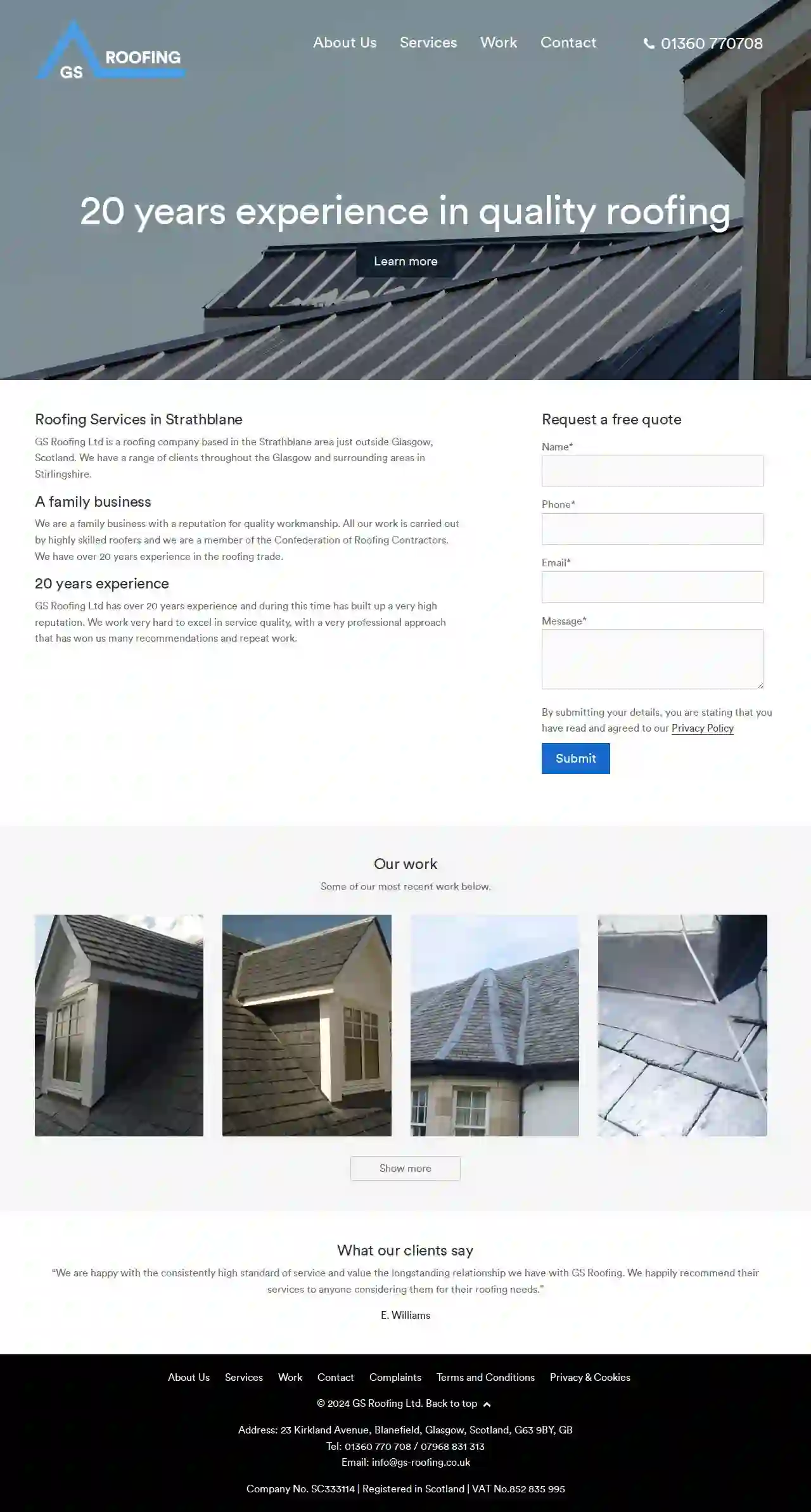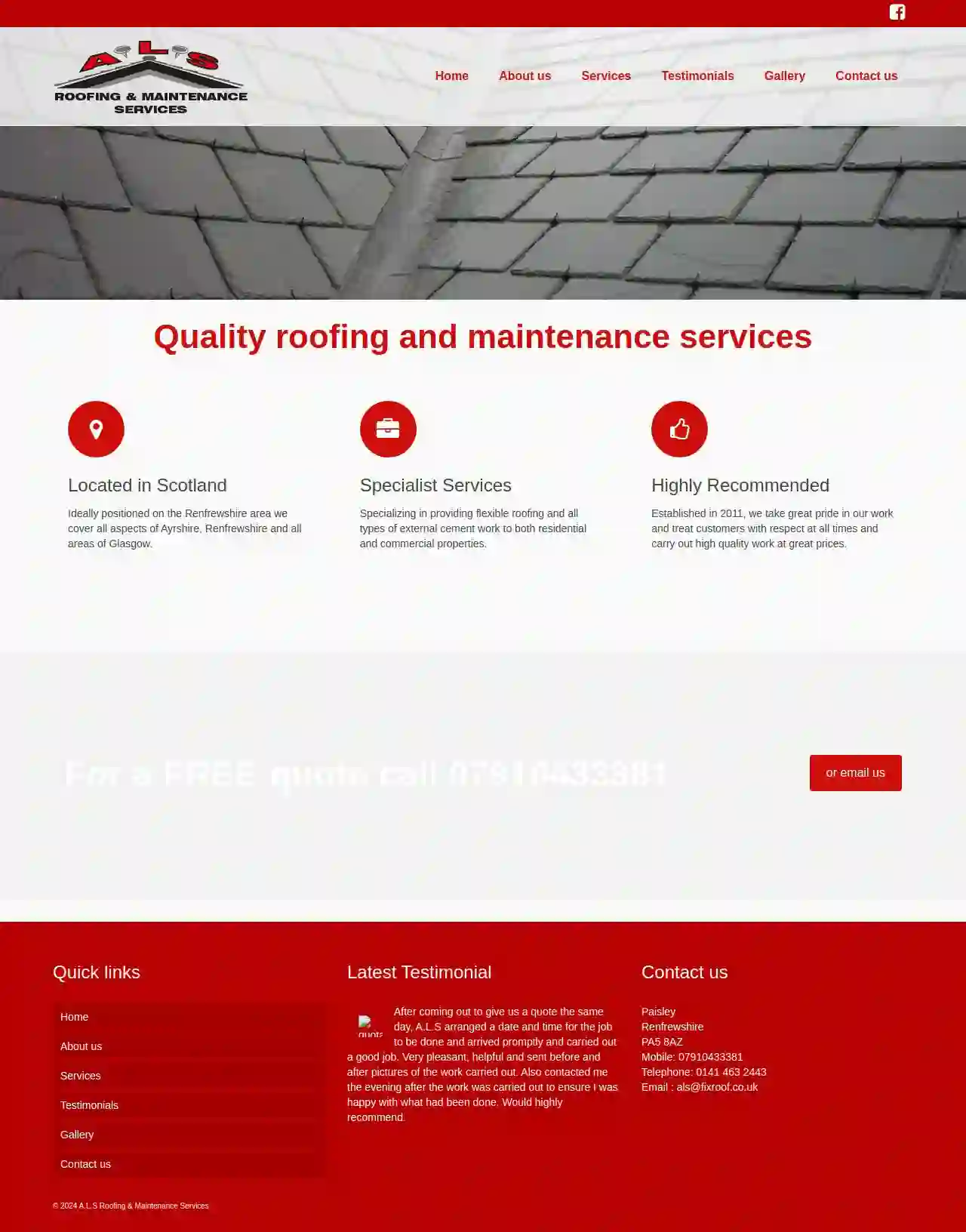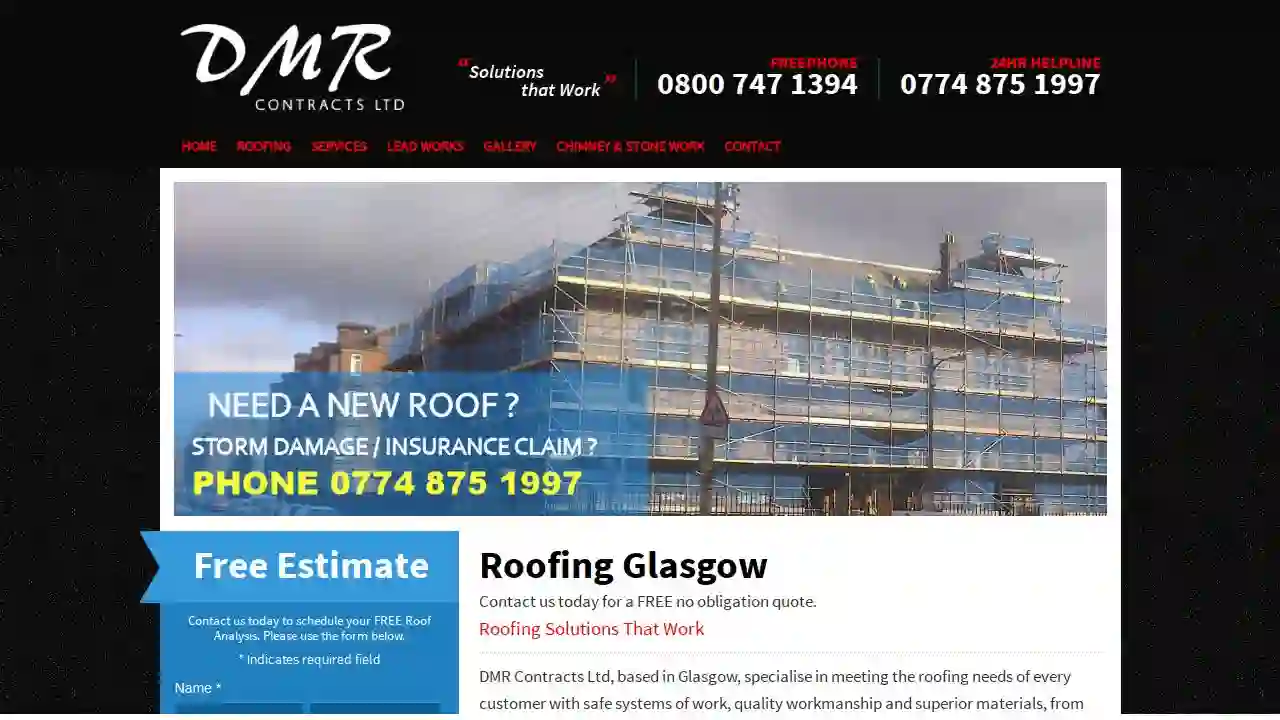Roofing Companies Garelochhead
Find Roofing Services in Garelochhead
Receive up to 3 Roofing Service quotes for your project today! Compare profiles, reviews, accreditations, portfolio, etc... and choose the best offer.

ASAP Roofing & Building Ltd
4.713 reviews272 Bath Street, Glasgow, G2 4JR, GBAsap roofingAll Aspects Of Roofing Covered | Glasgow & Surrounding Areas Call Today About us Family Run.At ASAP Roofing we are a family run roofing contractor based in Glasgow covering the city & surrounding areas specializing in historic slate & industrial roofing. Call Our Office Today On - 0141 673 0030 West end Based.With our office based in Bath Street and our depot based in Partick it allows us to attend to any emergency call outs in a speedily manner.
- Services
- Why Us?
- Gallery
Get Quote
Dumbarton Roofing Services
4.953 reviewsHelensburgh, Scotland, Main Street, G82 4, GBDumbarton Roofing Services is a professional and reliable roofing company based in Helensburgh, Scotland. We offer a wide range of roofing services, including new roof installations, roof repairs, flat roof work, gutters and fascias, and sandstone restoration. Our team of highly skilled local contractors is dedicated to providing high-quality results at affordable prices. We work closely with our clients to understand their specific needs and provide tailored solutions. Our services combine professionalism, reliability, and expertise to ensure that our customers receive the best possible results. We have worked with many satisfied clients in Helensburgh, Glasgow, and surrounding areas, and we are committed to providing exceptional service and results.
- Services
- Why Us?
- Accreditations
- Our Team
- Testimonials
- Gallery
Get Quote
G S Roofing Ltd
48 reviews23 Kirkland Avenue, Blanefield, G63 9BY, GBGS Roofing Ltd is a family-run roofing company based in Strathblane, just outside Glasgow, Scotland. We serve a range of clients throughout Glasgow and the surrounding areas in Stirlingshire. With over 20 years of experience in the roofing trade, we have built a strong reputation for quality workmanship and a professional approach. Our team of highly skilled roofers is dedicated to providing excellent service and exceeding customer expectations. We are proud members of the Confederation of Roofing Contractors, ensuring we adhere to the highest industry standards. At GS Roofing Ltd, we understand the importance of a reliable and durable roof. That's why we use only the best materials and techniques to ensure long-lasting results. Whether you need a new roof installation, repairs, or maintenance, our team has the expertise to handle any project, big or small. We are committed to providing our clients with transparent pricing, clear communication, and a stress-free experience. Contact us today for a free quote and let us help you protect your home or business with a quality roof from GS Roofing Ltd.
- Services
- Why Us?
- Accreditations
- Our Team
- Testimonials
- Gallery
Get Quote
A.L.S Roofing & Roughcasting Services
Paisley, PA5 8AZ, GBQuality roofing and maintenance services Located in ScotlandIdeally positioned on the Renfrewshire area we cover all aspects of Ayrshire, Renfrewshire and all areas of Glasgow.Read More Specialist ServicesSpecializing in providing flexible roofing and all types of external cement work to both residential and commercial properties.Read More Highly RecommendedEstablished in 2011, we take great pride in our work and treat customers with respect at all times and carry out high quality work at great prices.Read More
- Services
- Why Us?
- Our Team
- Testimonials
- Gallery
Get Quote
Rooflinings & Cladding Ltd
52 reviewsCollege Milton, East Kilbride, 5 Springburn Place, G74 5NU, GBWe are an independent roofing company based in East Kilbride, specialising in industrial roofing & cladding. We have been established for over 15 years, which means we have a wealth of experience in the industry. We pride ourselves on adhering to a high standard of workmanship while maintaining our excellent safety record. We offer a range of roofing services including new construction, re-roofing, retrofit over roofing, cladding and maintenance work. We also repair, reline, or replace defective boundary wall / valley gutters and rainwater pipes. We operate throughout Scotland and specialise in industrial roofing and cladding. We also offer consultancy-based services including Site Surveys and Health & Safety reports.
- Services
- Why Us?
- Gallery
Get Quote
Elite Metal Roofing Limited
21 Hunter Street, East Kilbride, G74 4LZ, GBAt Elite Metal Roofing, we pride ourselves on being a reputable and skilled team of professional roofing suppliers and installers. We offer a comprehensive range of services, including flat roof installations, cladding installations, and guttering services. Our team holds Level 2 Diplomas in Roof Sheeting and Cladding, is qualified in Emergency First Aid at Work, and is associated with the International Powered Access Federation. We are committed to providing our clients with peace of mind, knowing they are in capable hands. We understand the importance of a reliable and knowledgeable contractor for projects like new roofing or cladding. From start to finish, we guarantee excellent customer service. We work seven days a week to accommodate your busy schedule and can provide a quote, timescale, and keep you updated every step of the way. We take pride in our high-quality workmanship and ensure all work is completed to the highest standard. If you need advice on the best roofing solution for your property, don't hesitate to contact us. Why Choose Elite Metal Roofing? Competitive Prices Quality Workmanship Bespoke Service We specialize in industrial roof sheeting and cladding services, with experience working on numerous warehouses and factories. Our services include: Industrial roof sheeting Wall cladding Single ply roofing Site assembled built up metal systems Standing seam roofing Composite panel roofing and cladding Flat to pitched roof conversions Flat roofing Steel roofing Gutter repairs and cleaning Roof repairs and maintenance, including storm damage Insurance work If you don't see what you need, please contact us to discuss your specific requirements. Testimonials "I used Elite Metal Roofing to undertake recent re-roofing works to our industrial unit. Great workmanship and very easy to deal with!" Dayna H. Yell Review "Fantastic service from David who replaced all the old gutters and downpipes. Most helpful service. Much appreciated, I will definitely use Elite Metal Roofing again. I highly recommend them!" Ellen M. Yell Review
- Services
- Why Us?
- Accreditations
- Our Team
- Testimonials
- Gallery
Get Quote
Glasgow's Finest Roofing Company
32 reviews100 Holloway Head, Birmingham, B1 1AA, GBDMR Contracts is a leading provider of commercial construction services in the UK. With over 20 years of experience, we have a proven track record of delivering high-quality projects on time and within budget. Our team of expert professionals is dedicated to providing our clients with the best possible service. We offer a wide range of services, including new build, refurbishment, fit-out, and maintenance. We are committed to using the latest technologies and techniques to ensure that our projects are completed to the highest standards. At DMR Contracts, we understand that every project is unique. That's why we take the time to get to know our clients and their needs. We work closely with them throughout the entire project lifecycle, from initial concept to final handover. Our goal is to exceed our clients' expectations and build long-lasting relationships. We are proud to have a strong reputation for quality, reliability, and customer satisfaction. Our commitment to excellence has earned us the trust of many leading businesses in the UK.
- Services
- Why Us?
Get Quote
The Metal Roof Company
GBThe Metal Roof Company is a leading supplier of standing seam metal roofing materials, including zinc, steel, and copper roofing. They also offer a range of rainwater goods, such as Lindab guttering and downpipes, available for next-day delivery. Their flagship product is GreenCoat PLX Pro BT, a high-grade steel used for standing seam roof cladding, often considered an alternative to zinc roofing, zinc cladding, and copper. The company serves projects of all sizes nationwide. They pride themselves on providing excellent customer service and expert advice, helping clients choose the best roofing solution for their needs.
- Services
- Why Us?
- Accreditations
- Our Team
- Testimonials
- Gallery
Get Quote
Johnston
4.52 reviewsGBLanarkshire Roofing Network is a network of trusted roofing professionals serving Lanarkshire and surrounding areas. We offer a comprehensive range of roofing services for both domestic and commercial properties, including roof repairs, flat roofing, pitched roofing, fascias and soffits, and more. Our members are highly skilled and experienced in all aspects of roofing, ensuring quality workmanship and customer satisfaction. We understand the importance of a well-built roof, and we are committed to providing reliable and durable solutions to protect your property. Whether you need a small repair or a complete roof replacement, our team can help. Contact us today for a free quotation and let us take care of your roofing needs.
- Services
- Why Us?
- Accreditations
- Our Team
- Testimonials
- Gallery
Get Quote
Roofseals
4.846 reviewsHuntershill Village, 102 Crowhill Road, Unit 40, Bishopbriggs, G64 1RP, GBRoofseals is a family run roofing company in Glasgow, we specialise in solving flat roof problems of roofs on both residential and commercial projects. We are experts in our line of business and have carried out some of the most complex projects in our business area, only by using quality products and fully trained staff are we able to offer a guarantee that our customers are always completely satisfied. We offer a complete flat roofing service, our work includes repairs and improvements to commercial or public buildings, replacing or installing an overlay to a home flat roof or installing a modern membrane roof on top of the increasingly popular garden lounges or offices. Whatever your flat roofing concern, we can help. We currently operate throughout the central Scotland area, but this is not a restriction. We are a growing business and will endeavour to serve any area of Scotland and further. So, before you consider wasting your money on replacing your flat roof, please give us a call for a free flat roof survey and quotation. Our surveyors are only interested in making sure our potential customers are fully at ease with no fancy gimmicks and no high-pressure sales tactics.
- Services
- Why Us?
- Gallery
Get Quote
Over 12,314+ Roofers onboarded
Our roofing experts operate in Garelochhead & surroundings!
Roofyng.co.uk has curated and vetted the Best Roofing Companies arround Garelochhead. Find the most trustworthy contractor today.
Frequently Asked Questions About Roofing Companies
- Clear the Area: Remove any vehicles, outdoor furniture, or other items from around your house to provide the roofing crew with easy access.
- Protect Landscaping: Cover plants, shrubs, and other landscaping elements near the house with tarps or plastic sheeting to protect them from falling debris.
- Clear the Attic: Remove or cover items stored in your attic, as dust and debris might fall through during the removal of the old roof.
- Notify Neighbors: It's courteous to inform your neighbors about the upcoming roof replacement project, especially if it's likely to be noisy or disruptive.
- Discuss Logistics with the Contractor: Coordinate with the roofing contractor regarding access to your property, parking arrangements, and any special instructions or concerns you have.
- Roof size and complexity
- Roofing material chosen
- Local labor costs
- Accessibility of the roof
- Removal of existing roofing
- Additional features (skylights, chimneys, etc.)
- Metal roofs: Reflect sunlight, reducing cooling costs.
- Tile roofs: Offer thermal mass, regulating temperature.
- Cool roofs: White or light-colored roofs with high solar reflectance.
- Green roofs: Vegetated roofs providing insulation and reducing heat absorption.
How do I prepare for a roof replacement?
How much does a new roof cost in the UK?
What are some energy-efficient roofing options?
What is the difference between a roofer and a general contractor?
Roofer: Specializes in roof installations, repairs, and replacements. They have expertise in roofing materials, techniques, and safety practices specific to roofing.
General Contractor: Oversees and manages entire construction projects, including hiring and coordinating subcontractors, such as roofers, electricians, plumbers, etc. They handle overall project planning, scheduling, and budgeting.
For roofing projects, it's generally best to hire a roofing contractor who specializes in roof work.
How do I prepare for a roof replacement?
- Clear the Area: Remove any vehicles, outdoor furniture, or other items from around your house to provide the roofing crew with easy access.
- Protect Landscaping: Cover plants, shrubs, and other landscaping elements near the house with tarps or plastic sheeting to protect them from falling debris.
- Clear the Attic: Remove or cover items stored in your attic, as dust and debris might fall through during the removal of the old roof.
- Notify Neighbors: It's courteous to inform your neighbors about the upcoming roof replacement project, especially if it's likely to be noisy or disruptive.
- Discuss Logistics with the Contractor: Coordinate with the roofing contractor regarding access to your property, parking arrangements, and any special instructions or concerns you have.
How much does a new roof cost in the UK?
- Roof size and complexity
- Roofing material chosen
- Local labor costs
- Accessibility of the roof
- Removal of existing roofing
- Additional features (skylights, chimneys, etc.)
What are some energy-efficient roofing options?
- Metal roofs: Reflect sunlight, reducing cooling costs.
- Tile roofs: Offer thermal mass, regulating temperature.
- Cool roofs: White or light-colored roofs with high solar reflectance.
- Green roofs: Vegetated roofs providing insulation and reducing heat absorption.
What is the difference between a roofer and a general contractor?
Roofer: Specializes in roof installations, repairs, and replacements. They have expertise in roofing materials, techniques, and safety practices specific to roofing.
General Contractor: Oversees and manages entire construction projects, including hiring and coordinating subcontractors, such as roofers, electricians, plumbers, etc. They handle overall project planning, scheduling, and budgeting.
For roofing projects, it's generally best to hire a roofing contractor who specializes in roof work.